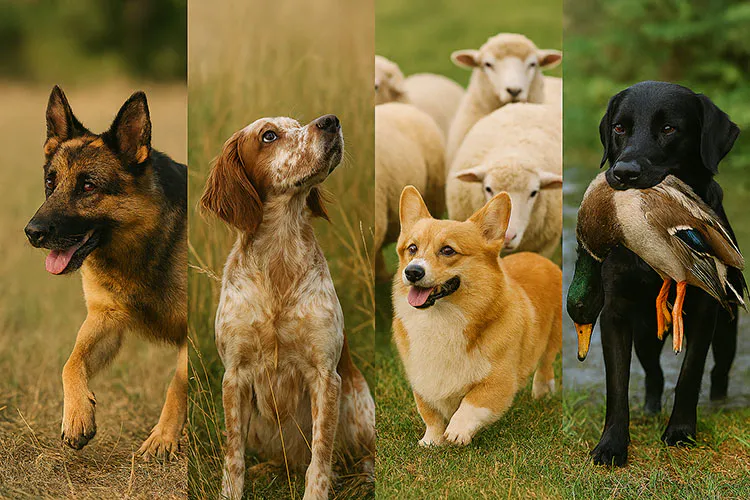
What are breed groups?
For as long as people have kept dogs, they have tried to make sense of the many shapes, sizes and temperaments by grouping them.
In the modern world this has been formalised by kennel clubs, with the Kennel Club (KC) in the United Kingdom and the American Kennel Club (AKC) in the United States being the most influential. Both organisations divide recognised breeds into groups, but they do not always agree on where a breed belongs. These groups are not just tidy categories for shows; they reflect centuries of history, human needs and sometimes heated debate.
Why debate? Because inclusion in these groups can be pretty arbitrary. Because early breeds fulfilled many roles from hunting to companionship, their inclusion in a modern group is based on whichever trait has been considered most important by one of the kennel clubs. It also doesn’t help that the utility (non-sporting) group is essentially a dumping ground for any breed that doesn’t fit neatly into any of the others!
That said, the groups are a useful starting point, as they can help us understand why a breed looks and behaves as it does. A Border Collie’s intense stare makes sense when you know it was bred to control sheep, and a Beagle’s determination to follow a scent is no surprise when you know it is a hound. Yet it is important to remember that these are broad categories, not strict rules. Individual dogs may not fit the stereotype of their group.
The groups
The Kennel Club in the UK currently recognises seven groups. These are:- Gundog
- Hound
- Pastoral
- Terrier
- Toy
- Utility
- Working
The American Kennel Club recognises seven as well, but with slightly different names and definitions:
- Sporting (Gundog UK)
- Hound
- Herding (Pastoral UK)
- Terrier
- Toy,
- Non-Sporting (Utility UK)
- Working
At first glance the lists look similar, but the differences reveal how each country has developed its own traditions.
The Gundog group in the UK, known as the Sporting group in the US, includes breeds developed to work with hunters. Retrievers, Spaniels, Setters and Pointers are the classic examples. A Labrador Retriever is the most obvious member, but the group also includes breeds that surprise many people. The Irish Water Spaniel, with its curly coat and clownish personality, is a gundog despite looking more like a poodle to the untrained eye. In the US, the Sporting group is almost identical, but the placement of certain breeds differs. The Dalmatian, for instance, is in the Non-Sporting group in the US, while in the UK it is placed in Utility.
The Hound group is one of the oldest. These are the dogs bred to hunt by sight or scent. Greyhounds, Beagles and Bloodhounds are obvious examples but this group also contains breeds that might surprise. The Dachshund, often thought of as a lap dog, is in fact a hound bred to go to ground after badgers. In the US and UK the Hound groups are broadly similar, though the emphasis on scent hounds is stronger in American traditions.
The Pastoral group in the UK (Herding group in the US) cover dogs bred to work livestock. Border Collies, German Shepherd Dogs and Old English Sheepdogs are well known members. What surprises many is that the Corgi, with its short legs and cheerful expression, is a serious herding dog. In the US, the Herding group was only created in 1983, before which these breeds were lumped into the Working group. This shows how kennel clubs adapt over time to reflect a clearer understanding of function.
The Terrier group is perhaps the most distinctively British. These dogs were bred to control vermin and to work in holes in the ground. Jack Russell Terriers, though not recognised by the American Kennel Club under that name (they're known as Parson Russell Terriers), are iconic. The group is full of feisty characters, from the tiny Norfolk Terrier to the larger Airedale. In the US, the Terrier group is similar, but with some breeds recognised under different standards. The American Pit Bull Terrier, for example, is not recognised by the AKC at all, which is one of the most controversial omissions in the world of breed groups.
The Toy group is straightforward in both countries. These are the small companion dogs, often bred down from larger breeds. The Pug, the Chihuahua and the Cavalier King Charles Spaniel are typical examples. Yet there are surprises here too. The Yorkshire Terrier, despite its name, is classed as a Toy in both the UK and US, rather than a Terrier. This reflects its modern role as a companion rather than its original ratting purpose.
The Utility group in the UK has no direct equivalent in the US. It is a catch-all for breeds that do not fit neatly elsewhere. The Dalmatian, Bulldog and Poodle are all here. In the US, these breeds are placed in the Non-Sporting group. This highlights one of the grey areas of classification. The Bulldog, for example, was once a working dog used for bull-baiting, but today it is a companion. Should it be in Working, Utility or Non-Sporting? The answer depends on which kennel club you ask.
The Working group in both countries includes the large, powerful dogs bred for guarding, pulling or rescue. The Saint Bernard, the Rottweiler and the Siberian Husky are classic examples. Yet even here there are surprises. The Dobermann, often thought of as a guard dog, is in the Working group in the US but in Utility in the UK. This difference reflects how each club interprets the breed’s purpose.
These groups are not without controversy. Critics argue that the divisions are artificial and sometimes outdated... and it's easy to see why. A breed’s original purpose may no longer be relevant, yet its group placement remains fixed. The Bulldog and the Dalmatian are prime examples. Others point out that the groups can influence public perception; for example, a dog placed in Working may be seen as unsuitable for families, even if individual dogs are gentle. Conversely, a Toy breed may be assumed to be easy, when in fact some are incredibly demanding and not ideal for novice owners.
There are also debates about recognition itself. The American Kennel Club does not recognise some breeds that the UK Kennel Club does, and vice versa. The Jack Russell Terrier is recognised in the UK but not in the US, where the Parson Russell Terrier is the official version. This can cause confusion for owners and breeders, and it shows how politics and tradition play a role alongside function.
The history of breed groups is a story of people as much as dogs. Hunters, shepherds, nobles and city dwellers all shaped the breeds we know today. Kennel clubs then formalised these divisions, sometimes tidying up messy realities into neat categories... and sometimes, arguably, making things a little messier The result is a system that is both helpful and flawed, full of tradition and debate. For anyone interested in dogs, knowing the groups is part of the essential knowledge, but so is questioning them.
Breed groups in the UK and US are more than labels for dog shows. They are windows into history, culture and human priorities. They tell us what people once needed from dogs and how those needs have changed. They also remind us that dogs are individuals, not just representatives of a category. Understanding the groups is a way to deepen our knowledge, but also to appreciate the variety and adaptability of dogs themselves.

